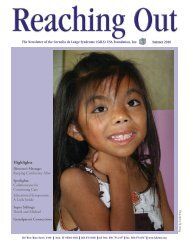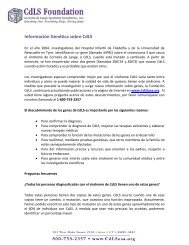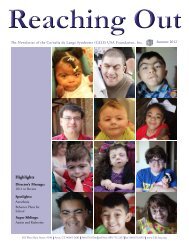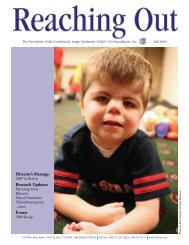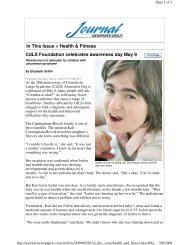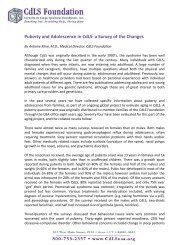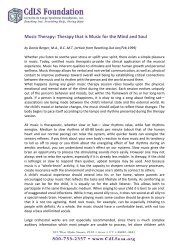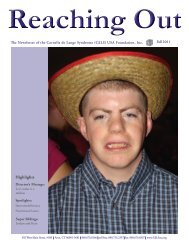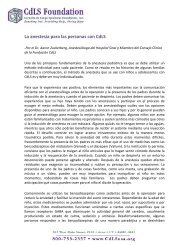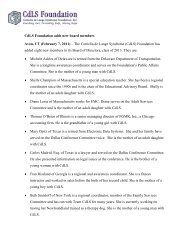Fall 2012 - CdLS
Fall 2012 - CdLS
Fall 2012 - CdLS
You also want an ePaper? Increase the reach of your titles
YUMPU automatically turns print PDFs into web optimized ePapers that Google loves.
Reaching Out<br />
The Newsletter of the Cornelia de Lange Syndrome (<strong>CdLS</strong>) USA Foundation, Inc.<br />
<strong>Fall</strong> <strong>2012</strong><br />
Highlights<br />
Director’s Message:<br />
Making Your Opinions<br />
Our Reality<br />
Spotlights:<br />
Research Updates<br />
<strong>CdLS</strong> and Autism<br />
Super Siblings:<br />
Rich and Joseph<br />
Photo by Rick Guidotti<br />
302 West Main Street, #100 Avon, CT 06001-3681 860.676.8166 toll free: 800.753.2357 fax: 860.676.8337 www.<strong>CdLS</strong>usa.org
Director’s Message<br />
Making Your Opinions Our Reality<br />
The <strong>CdLS</strong> Foundation began a strategic planning process earlier this year to identify its<br />
direction and focus over the next three years. At the core of this process was finding out<br />
what you—our families and professionals—wanted.<br />
After interviewing past and present leaders, volunteers and board members, then surveying<br />
parents, relatives and professionals, five areas of focus were formed:<br />
• Improve awareness of <strong>CdLS</strong><br />
• Make clinics for all ages more accessible<br />
• Provide more opportunities for personal interaction for all ages and all abilities on the spectrum<br />
• Increase funding for basic science, educational and clinical research<br />
• Build a strong, sustainable infrastructure through increasing and diversifying revenue<br />
Input on these five areas was then gathered at the <strong>2012</strong> National Family Conference during two focus groups of families<br />
and professionals.<br />
The culmination of this six-month project was 10 objectives, some of which include:<br />
• one additional Foundation sponsored family gathering per year over the next three years, for a total of eight<br />
annually;<br />
• additional multi-disciplinary clinics;<br />
• annual research funding with at least a portion of the funds going to a new researcher when possible;<br />
• an exhibit at one or more professional conferences per year, such as the American Academy of Pediatrics.<br />
Staff will be moving forward with these projects and others over the next several years. Some will be implemented as<br />
soon as this coming year, such as a sixth family gathering, targeted outreach to professionals and additional online<br />
learning modules.<br />
Throughout this process, the Foundation depended on your involvement to strategize a plan that would impact its<br />
future—and your child’s future. Thanks to everyone who shared ideas and comments during the process. We could<br />
not have done it without you.<br />
Marie Concklin-Malloy<br />
Acting Executive Director<br />
4<br />
5<br />
Research Updates<br />
CHOP Researchers Busy on<br />
Several Research Fronts<br />
In This Issue<br />
10<br />
11<br />
Super Siblings:<br />
Rich and Joseph<br />
Mailbag<br />
6 Similarities and Differences of<br />
<strong>CdLS</strong> and Autism<br />
12<br />
Dress Down for <strong>CdLS</strong><br />
7<br />
A Closer Look at<br />
Autism<br />
13<br />
Team <strong>CdLS</strong> <strong>2012</strong> Recap<br />
8<br />
HDAC8 FAQ Sheet<br />
16<br />
Ask the Expert: What You<br />
Want to Know<br />
REACHING OUT<br />
2<br />
www.<strong>CdLS</strong>usa.org
An Update on the Genetic Causes of <strong>CdLS</strong><br />
By Antonie Kline, M.D., <strong>CdLS</strong> Foundation Medical Director<br />
In 2004, the news that “the” Cornelia de Lange Syndrome<br />
(<strong>CdLS</strong>) gene had been discovered was very much<br />
welcomed, following years of searching and many families<br />
donating blood samples towards this cause.<br />
Now, eight years later, the picture seems much more<br />
confusing. Despite the knowledge of the most recently<br />
reported fourth <strong>CdLS</strong> gene (HDAC8) and another closely<br />
related gene (RAD21), the percentage of people with <strong>CdLS</strong><br />
having detectable changes (mutations) on testing remains under 70 percent, and<br />
the diagnosis is still made clinically. You may ask, “How can this be?”<br />
We now know that <strong>CdLS</strong> is caused by changes in genes related to the formation<br />
and function of the protein cohesin, which is actually a protein complex made<br />
up of many sub-parts. Cohesin itself is extremely important, not only in the<br />
developing embryo and fetus, but also in all humans after delivery, both in cell<br />
division and repair and in gene regulation. Cohesin is loaded onto half of each<br />
chromosome, or sister chromatids, prior to cell division, via a loading protein,<br />
coded for by the gene NIPBL, which was the first gene discovered and the most<br />
commonly detected (in about 60 percent of all individuals with <strong>CdLS</strong>).<br />
Core components of the cohesin ring, formed around the sister chromatids, are<br />
coded for by the genes SMC1A and SMC3, accounting for five percent and less<br />
than one percent respectively, of the mutations detected in all individuals. Two<br />
more recently discovered genes also involved in the cohesin complex are RAD21<br />
and HDAC8, again each accounting for less than one percent and five percent<br />
respectively in all individuals tested for <strong>CdLS</strong>.<br />
RAD21 is also a core component of the cohesin ring and HDAC8 helps stabilize<br />
the cohesin complex. As more genes related to <strong>CdLS</strong> are detected, we will gain<br />
a better understanding of cohesin, how it works and how it affects pathways in<br />
the cell.<br />
If functioning improperly, many important cell functions cannot be carried out.<br />
If unable to function at all, the individual cannot survive. It is likely that the<br />
most severe mutations are not viable at birth, but rather are lost prenatally. Less<br />
severe mutations cause delayed or abnormal function of cohesin.<br />
Clinical testing is recommended for individuals whose parents may wish to<br />
undergo prenatal diagnosis for future pregnancies by testing for a specific mutation<br />
(possible only if the mutation can be detected in an older child with <strong>CdLS</strong>), or<br />
in individuals who are less typical. On page 8 is a fact sheet on the new gene,<br />
HDAC8, along with additional information on testing.<br />
Reaching Out<br />
Published Since 1977<br />
(ISSN 1097-3052)<br />
Cornelia de Lange Syndrome<br />
Foundation, Inc.<br />
Incorporated December 1981<br />
email: info@<strong>CdLS</strong>usa.org<br />
www.<strong>CdLS</strong>usa.org<br />
BOARD OF DIRECTORS<br />
President. .........Marc Needlman, IL<br />
Vice Presidents.. . . . . . . . . . . . . . . . . . .<br />
. . . . . . . . Eileen Ahearn, M.D., Ph.D., WI<br />
. . . . . . . . . . . . Robert Boneberg, Esq., NJ<br />
. .Kari Cunningham-Rosvik, A.P.R.N, WA<br />
Treasurer ........ Thomas O’Brien, IL<br />
Secretary. ........... Garth Black, PA<br />
Directors..... Michele Churchman, DE<br />
.. . . . . . . . . . . . David Barnes, Esq., NH<br />
. . . . . . . . . . . . . . . .Shelly Champion, MA<br />
. . . . . . . . . . . . . . . . .Catherine Caron, NH<br />
. . . . . . . . . . . Richard Haaland, Ph.D., GA<br />
. . . . . . . . . . . . . . . . . . . David Harvey, GA<br />
. . . . . . . . . . . . . . . . . . . Dianne Lessa, MA<br />
. . . . . . . . . . . . . . Carlos Madrid, Esq., TX<br />
. . . . . . . . . . . . . . .Wendy Miller, Esq., CA<br />
. . . . . . . . . . . . . . . . . . . . . Mary Opitz, TX<br />
. . . . . . . . . . . . . . . . . . . Fran Rissland, GA<br />
. . . . . . . . . . . . . . . . . . . Beth Smisloff, NY<br />
PROFESSIONAL STAFF<br />
ACTING EXECUTIVE DIRECTOR<br />
Marie Concklin-Malloy<br />
MEDICAL DIRECTOR<br />
Antonie Kline, M.D.<br />
DEVELOPMENT MANAGER<br />
Gail Speers<br />
FAMILY SERVICE MANAGER<br />
Deirdre Summa, M.S.W.<br />
FINANCE MANAGER<br />
Kelly Brown<br />
FAMILY SERVICE COORDINATORS<br />
Lynn Audette, M.S.W.<br />
Janette Peracchio, M.Ed.<br />
GRAPHIC DESIGNER/WEB MASTER<br />
Francesca Scognamiglio<br />
COMMUNICATIONS COORDINATOR<br />
Brenda Shepard<br />
DEVELOPMENT COORDINATOR<br />
Kellie German Santiago<br />
All information contained herein is for<br />
the reader’s personal interest. Articles on<br />
treatments, medications, or procedures, etc.<br />
are not guides for self-treatment. Questions<br />
should be discussed with your doctor or other<br />
appropriate professionals. The <strong>CdLS</strong> Foundation<br />
does not endorse any product advertised<br />
and/or mentioned in Reaching Out.<br />
1.800.753.2357<br />
3 <strong>Fall</strong> <strong>2012</strong>
The Science of Sleep<br />
Disturbances in <strong>CdLS</strong><br />
By Stacey Ishman, M.D., M.P.H., Johns Hopkins Medical<br />
Center and member of the <strong>CdLS</strong> Foundation Clinical<br />
Advisory Board<br />
Studies show that one to four percent of children in the<br />
general pediatric population have moderate to severe sleep<br />
disordered breathing (SDB); however, sleep disturbance<br />
is not well characterized in Cornelia de Lange Syndrome<br />
(<strong>CdLS</strong>).<br />
In 2010, we surveyed the caregivers of 22 patients<br />
with <strong>CdLS</strong> using three validated sleep questionnaires:<br />
Pediatric Sleep Questionnaire (PSQ), Pediatric Daytime<br />
Sleepiness Scale (PDSS), and OSA18. These use a number<br />
of questions to measure symptoms of sleep disordered<br />
breathing, daytime sleepiness, snoring, and inattentive/<br />
hyperactive behavior.<br />
Results of the study illustrated that 35 to 36 percent of<br />
those with <strong>CdLS</strong> had symptoms consistent with SDB;<br />
while, 23 to 36 percent of participants were characterized<br />
as “sleepy.”<br />
Previous evaluations of individuals with Smith-Magenis<br />
Syndrome, who have similar levels of self-injurious<br />
behavior and intellectual disability, suggest there is a<br />
correlation between sleep disturbance and insomnia or<br />
circadian rhythm disorders.<br />
In <strong>2012</strong>, we collated the results of a sleep history<br />
questionnaire completed by the caregivers of 31 patients<br />
with <strong>CdLS</strong> to assess the prevalence of insomnia or<br />
circadian rhythm disorders.<br />
The results showed that the <strong>CdLS</strong> study population had<br />
significant difficulty falling asleep (75 percent pediatric,<br />
33 percent adult) and difficulty staying asleep (52 percent<br />
pediatric, 33 percent adult).<br />
The data suggests that individuals with <strong>CdLS</strong> have a<br />
predisposition towards insomnia and circadian rhythm<br />
disorders; however, more study is necessary to better<br />
characterize the relationship between sleep disturbance<br />
and <strong>CdLS</strong>.<br />
To further characterize this relationship, we are currently<br />
asking caregivers of patients with <strong>CdLS</strong> to complete a<br />
REACHING OUT<br />
4<br />
survey that more specifically looks at these symptoms.<br />
It is available online at: http://bit.ly/Mztf97. We are<br />
also collecting sleep studies already carried out at home<br />
institutions.<br />
For a paper copy, email researchsleep@gmail.com.<br />
Research Holds<br />
Promise for<br />
Treatments<br />
By Julie Woodman, Ph.D. Candidate,<br />
University of Colorado<br />
In patients with Cornelia de Lange Syndrome (<strong>CdLS</strong>), a<br />
protein called NIPBL is frequently damaged. My research<br />
focuses on furthering the molecular characterization of<br />
NIPBL to understand how a defective version of this<br />
protein can lead to the developmental problems observed<br />
in people with <strong>CdLS</strong>.<br />
Because the NIPBL protein is so similar in humans<br />
and other simple organisms, I have been able to study<br />
the function of this important protein using baker’s<br />
yeast as a model system. I have found that NIPBL’s<br />
yeast counterpart, Scc2, is chemically modified by<br />
phosphorylation, which has been known for many years<br />
to affect the functions of proteins.<br />
From my research, I determined that this modification<br />
protects Scc2 from being cut, or cleaved, so that it can<br />
bind DNA, where it interacts with other proteins to carry<br />
out its critical function.<br />
By gaining insight to this complicated process, I can<br />
begin to understand how <strong>CdLS</strong> originates. It is my hope<br />
that with this newly acquired information, I will identify<br />
factors that contribute to onset of the syndrome and<br />
explore the possibility of treating and preventing <strong>CdLS</strong><br />
itself, rather than its symptoms.<br />
Julie Woodman was a recipient of a 2011 <strong>CdLS</strong> Foundation<br />
small grant. Her research project, “Molecular Origins and<br />
Mechanisms of Cornelia de Lange Syndrome,” aimed to study<br />
the underlying mechanisms involved in targeting cohesin to<br />
particular regions of the chromosome.<br />
www.<strong>CdLS</strong>usa.org
CHOP Researchers Busy on<br />
Several Research Fronts<br />
By Ian Krantz, M.D., Director, Center for Cornelia de Lange<br />
Syndrome and Related Diagnoses, Children’s Hospital of<br />
Philadelphia, and member of the <strong>CdLS</strong> Foundation Clinical<br />
Advisory Board<br />
Through work with a large number of colleagues and<br />
collaborators, our team here at CHOP continues to<br />
develop its strong focus on understanding the molecular<br />
and clinical aspects of <strong>CdLS</strong>.<br />
This work is supported by a grant from the National<br />
Institutes of Health in collaboration with Dr. Dale Dorsett<br />
at Saint Louis University School of Medicine and Drs.<br />
Arthur Lander and Anne Calof at University of California,<br />
Irvine, as well as support from endowed funds here at<br />
the CHOP Center for Cornelia de Lange Syndrome and<br />
Related Diagnoses and grant funding from the <strong>CdLS</strong><br />
Foundation. Here is an update about where we are with<br />
research and where we are hoping to be in a few years.<br />
Identification of the underlying molecular etiology<br />
of the <strong>CdLS</strong><br />
Our group at CHOP has identified and characterized<br />
several genes that are causative of <strong>CdLS</strong> when mutated,<br />
including NIPBL, SMC1A, SMC3, RAD21 and HDAC8.<br />
Still, approximately 35 percent of individuals with <strong>CdLS</strong><br />
don’t have a mutation in any of those genes, which<br />
indicates that there are more genes to be found.<br />
All of the genes found to date are active in the structure<br />
or regulation of the cohesin complex. Cohesin has many<br />
functions, but its role in <strong>CdLS</strong> is as a “master switch” that<br />
regulates the turning on and off of many downstream<br />
genes. When cohesion is not functioning correctly,<br />
these downstream genes are dysregulated and lead to the<br />
constellation of symptoms we see in <strong>CdLS</strong>.<br />
We are looking for additional genes that cause <strong>CdLS</strong>, as<br />
well as characterizing the downstream genes dysregulated<br />
when cohesin is not functioning properly. These<br />
discoveries will hopefully lead to a detailed understanding<br />
of how these differences cause the individual features that<br />
we see in <strong>CdLS</strong> and ultimately lead to the development<br />
of targeted therapeutics for the syndrome.<br />
Developing a Drosophila model of <strong>CdLS</strong><br />
The first step in testing any potential therapeutic agents<br />
is to develop an animal model of <strong>CdLS</strong> that can be used<br />
to rapidly assess the effects of treatments. Cohesin defects<br />
in Drosophila (fruit flies) have been well studied, most<br />
notably by Dr. Dorsett. We are finding both structural<br />
and learning differences in flies with cohesin changes<br />
similar to those seen in people with <strong>CdLS</strong>. These flies<br />
provide an invaluable tool to assess the efficacy of potential<br />
treatments for <strong>CdLS</strong>.<br />
A human cellular model to study <strong>CdLS</strong><br />
A major breakthrough in stem cell research has increased<br />
our ability to understand the effects that mutations in<br />
cohesin genes have on human cells during early stages of<br />
embryonic development.<br />
We can now take cells (typically skin cells) from an<br />
individual with <strong>CdLS</strong> and reprogram these cells to dedifferentiate<br />
back to a stage (called “pluripotent”) so that<br />
we can induce them to become different cell types, such<br />
as early heart cells or early brain cells. This powerful new<br />
methodology will allow us to examine what is happening<br />
at the very early stages of the development of cells and<br />
tissues that go on to form our organ systems. This<br />
provides a much more direct window into understanding<br />
which genes are turned on or off inappropriately during<br />
development.<br />
Our hope is to identify specific targets for therapeutics,<br />
as well as to have a human cellular model system to see if<br />
candidate therapeutic drugs have an effect in normalizing<br />
this on/off pattern of gene expression.<br />
Clinical research<br />
Here at CHOP, there are many projects working to<br />
understand the clinical issues faced by individuals with<br />
<strong>CdLS</strong> and to improve our ability to more effectively<br />
manage these issues through their lives.<br />
We have ongoing studies to understand a multitude<br />
of clinical aspects, including prenatal features,<br />
congenital heart defects, immune functioning, platelet<br />
abnormalities, cognitive functioning and autism,<br />
hearing loss in <strong>CdLS</strong>, and causes of morbidity and<br />
mortality.<br />
1.800.753.2357<br />
5 <strong>Fall</strong> <strong>2012</strong>
Similarities and Differences of<br />
<strong>CdLS</strong> and Autism<br />
By Julia O’Connor, Ph.D., Kennedy Krieger<br />
Institute, and Department of Psychiatry<br />
and Behavioral Sciences, Johns Hopkins<br />
University School of Medicine; Co-chair<br />
<strong>CdLS</strong> Foundation Professional Development<br />
Committee<br />
Many syndromes, such as Cri du Chat, Fragile X and<br />
Rett, present with a range of impairments in the areas<br />
of communication, behavior, and emotion. Individuals<br />
with Cornelia de Lange Syndrome (<strong>CdLS</strong>) also present<br />
with impairments in these three areas. These are the areas<br />
that highlight the hallmark diagnostic symptoms for<br />
Autism Spectrum Disorder. For an individual to receive<br />
a diagnosis of autism, the following symptoms must be<br />
displayed:<br />
• qualitative impairment in social interaction;<br />
• qualitative impairment in communication; and<br />
• restricted repetitive and stereotyped patterns of<br />
behavior, interests and activities, as well as delays or<br />
abnormal functioning, with onset prior to age three,<br />
in (at least one of the following) social interaction,<br />
language as used in social communication, or<br />
symbolic or imaginative play.<br />
Some of the symptoms of autism that also occur in<br />
individuals diagnosed with <strong>CdLS</strong> include developmental,<br />
language and social development delays. The range of<br />
delay varies across individuals. Specifically, individuals<br />
diagnosed with <strong>CdLS</strong> are described as having receptive and<br />
expressive language delays with a significant discrepancy in<br />
these language skills. 3, 4 A similar discrepancy is described<br />
in individuals on the Autism Spectrum.<br />
Previous studies suggest a strong association between<br />
<strong>CdLS</strong> and Autism Spectrum Disorder. 1 For example,<br />
Berney and colleagues 1 reported that 53 percent of the<br />
49 <strong>CdLS</strong> individuals in their study displayed autism<br />
symptoms and these associations were not attributed to<br />
the level of intellectual disability. 7<br />
be less clear. Individuals with <strong>CdLS</strong> may present with<br />
increased anxiety, selective mutism, and shyness 2 that is<br />
not found in the autism group.<br />
In the Moss, Howlin, Magiati & Oliver article, 5 the<br />
<strong>CdLS</strong> group demonstrated a greater capacity to use eye<br />
contact and gestures in comparison to the autism group<br />
suggesting different social skills impairments across the<br />
groups.<br />
Further research is needed into the nature of the social,<br />
communicative and emotional impairments in <strong>CdLS</strong><br />
compared to individuals with Autism Spectrum Disorder<br />
with similar intellectual disability. Not only are we<br />
interested in what ways these groups present in a similar<br />
fashion, but also in what ways the <strong>CdLS</strong> group presents<br />
differently than the autism group. These studies could<br />
aide in the delineation of different subtypes of individuals<br />
with <strong>CdLS</strong> along with specific treatment strategies that<br />
would be more beneficial for the specific subgroups.<br />
1<br />
Berney T. P., Ireland M. & Burn J. (1999). Behavioral phenotype of<br />
Cornelia de Lange Syndrome. Archives of Disease in Childhood, 81, 333–6.<br />
2<br />
Collis, L., Oliver, C., & Moss, J. (2006). Low mood and social anxiety<br />
in Cornelia de Lange syndrome. Journal of Intellectual Disability Research,<br />
50, 791–800.<br />
3<br />
Cornish, K., & Munir, F. (1998). Receptive and expressive language<br />
skills in children with Cri du-Chat syndrome. Journal of Communication<br />
Disorders, 31, 73–81.<br />
4<br />
Goodban, M. T. (1993). Survey of speech and language skills with<br />
prognostic indicators in 116 patients with Cornelia de Lange Syndrome.<br />
American Journal of Medical Genetics, 47, 1059–63.<br />
5<br />
Moss, J., Howlin,P., Magiati, I., & Oliver, C. (<strong>2012</strong>). Characteristics of<br />
autism spectrum disorder in Cornelia de Lange syndrome. Journal of Child<br />
Psychology and Psychiatry, 53, 883–891.<br />
6<br />
Moss, J., Oliver, C., Berg, K., Kaur, K., Jephcott, G., & Cornish, K. (2008).<br />
Prevalence of autism spectrum phenomenology in Cornelia de Lange and Cri<br />
du Chat syndromes. American Journal on Mental Retardation, 113, 278-291.<br />
7<br />
Oliver, C., Arron, K., Berg, K., Burbidge, C., Caley, A., Duffay, S., Hooker,<br />
M., & Moss, J. (2005). A comparison of Cornelia de Lange, Cri du Chat,<br />
Prader-Willi, Smith-Magenis, Lowe, Angelman and fragile X syndromes.<br />
GeneticCounseling,13, 363–381.<br />
However, in the area of social interaction, the overlap<br />
in presentation across the <strong>CdLS</strong> and autism groups may<br />
REACHING OUT<br />
6<br />
www.<strong>CdLS</strong>usa.org
A Closer Look at Autism<br />
With a broad range of characteristics that can accompany<br />
Cornelia de Lange Syndrome (<strong>CdLS</strong>) much can be<br />
overlooked and misunderstood. Family members, teachers<br />
and doctors may have difficulties understanding the full<br />
extent of issues that can arise with a <strong>CdLS</strong> diagnosis.<br />
While adding additional diagnoses may cloud medical<br />
history even more, they can also provide additional<br />
services and understanding of the child as a whole.<br />
Here are two families’ stories of their experience with<br />
autism.<br />
“The reason we pursued an autism diagnosis was Dr. Chris<br />
Oliver (a psychologist and member of the <strong>CdLS</strong> World<br />
Scientific Advisory Council),” said Phyllis, mother of<br />
20-year-old Christian, who received an autism diagnosis<br />
at age eight.<br />
“We had a meeting with Dr. Oliver at a conference when<br />
Christian was seven. He told me to look into autism<br />
treatments to help with some of Christian’s <strong>CdLS</strong> related<br />
issues,” said Phyllis. “<strong>CdLS</strong> has a lot of similarities as those<br />
seen in children who have autism. To pursue this avenue<br />
seemed like a logical way to go for us.”<br />
For other families, autism was not initially on their mind.<br />
After reading an article about autism and <strong>CdLS</strong> in an<br />
old issue of Reaching Out, Teala, mother of eight-yearold<br />
Sydnee, thought her daughter had autistic behaviors.<br />
“I wasn’t pursuing an autism<br />
diagnosis at the time. I went<br />
with Sydnee to see a behavior<br />
specialist to find treatment<br />
for her trichotillomania<br />
(pulling hair out) and it was<br />
suggested then,” Teala said.<br />
Sydnee was diagnosed with<br />
autism at age six.<br />
Determining Autism Spectrum Disorders (ASDs) can<br />
be difficult with no medical test, like a blood test, for<br />
diagnosis. Rather, doctors and psychologists evaluate<br />
the child’s behavior and development in order to make<br />
a diagnosis.<br />
1.800.753.2357<br />
Sydnee<br />
“Sydnee had a psychological evaluation and I was<br />
interviewed. I filled out lots of paperwork and Sydnee<br />
was observed,” said Teala. “On the Childhood Autism<br />
Rating Scale (CARS), Sydnee was placed in the severely<br />
autistic range.”<br />
Christian also had a formal evaluation.<br />
“There were observations and many<br />
questions, however, it was an easy<br />
diagnosis. Christian rated higher<br />
than average (in the CARS),” said<br />
Phyllis.<br />
With an autism diagnosis, some<br />
families find benefits that follow,<br />
such as gaining services in school and Christian<br />
a better grasp of the child’s struggles. For Phyllis’ family,<br />
having the autism diagnosis helped Christian get onto<br />
state medical services lists and helped him gain services<br />
in school.<br />
“Even the professionals at school didn’t have a full<br />
understanding of autism, so you can imagine trying to<br />
explain <strong>CdLS</strong> to them,” she said. “People have a better<br />
understanding of autism, so it’s easier to work with<br />
doctors, especially those who may have never heard of<br />
<strong>CdLS</strong>.”<br />
Teala also said the diagnosis opened up more services for<br />
her daughter. “Sydnee’s treatment plan has changed. Her<br />
Individual Education Plan (IEP) has changed as well, and<br />
we work with a [local autism support program] called<br />
Globe Star, which she now qualifies for. We’re still waiting<br />
on an autism waiver waitlist.”<br />
Many children with <strong>CdLS</strong> fall within the autism<br />
spectrum. It may be beneficial for parents to explore this<br />
additional diagnosis. It is important to remember the<br />
diagnosis does not change or define who your child is.<br />
Hopefully, it provides you with a greater understanding<br />
of your child’s behavior and how they interact with the<br />
world and the people around them. The diagnosis also<br />
opens doors to a greater range of resources and services.<br />
“Obviously, you don’t just want another diagnosis. You<br />
need to look at what the diagnosis is going to do for<br />
your child.” said Teala.“If you think there’s a chance that<br />
it will open some doors or bring more help to you and<br />
your family, then it’s worth looking into, but you need<br />
to be ready to handle another diagnosis.”<br />
continued on page 14<br />
7 <strong>Fall</strong> <strong>2012</strong>
HDAC8 FAQ Sheet<br />
In July <strong>2012</strong>, the fourth “<strong>CdLS</strong> gene”—HDAC8—<br />
was announced. Many parents and professionals have<br />
questions about this latest finding and what it means.<br />
HDAC8 is an X-linked gene, meaning it is located on the<br />
X chromosome. The X and Y chromosomes are the sex<br />
chromosomes that determine whether an individual will<br />
be a boy or girl. Typically, a female has two Xs (XX) and<br />
a male has an X and Y (XY).<br />
Individuals who have the gene change in HDAC8 make<br />
up just a small portion of all people with <strong>CdLS</strong>.<br />
Sarah Noon, a genetic counselor at the Children’s<br />
Hospital of Philadelphia (CHOP) answers some common<br />
questions below.<br />
Q: Does the child have to be tested for the previous<br />
genes first before being tested for this gene?<br />
A: The University of Chicago has offered clinical testing<br />
for the genes NIPBL and SMC1A. Most recently, it began<br />
offering testing for SMC3, as well as the two new related<br />
genes, RAD21 and HDAC8. Together, approximately 4%<br />
of individuals with <strong>CdLS</strong> have a change in either SMC3,<br />
RAD21, or HDAC8.<br />
Research enrollment in a study conducted by Dr. Ian<br />
Krantz at the Children’s Hospital of Philadelphia is offered<br />
to individuals with <strong>CdLS</strong> or a <strong>CdLS</strong>-like phenotype<br />
who have had clinical testing of NIPBL, SMC1A and<br />
no mutations were identified. While it is preferred that<br />
SMC3, RAD21, and HDAC8 testing be completed prior<br />
to enrollment, this testing is currently not required to<br />
enroll. Submission of relevant clinical information,<br />
photographs, and consent forms are required.<br />
Q: Should mothers be tested?<br />
A: If a child has an identified mutation in the HDAC8<br />
gene, the mutation could have occurred as a new (de<br />
novo) event in that individual or it could have been<br />
inherited from a parent. Since women have two copies<br />
of the X chromosome, mothers can be carriers for an<br />
HDAC8 mutation. When a mother is a carrier for an<br />
HDAC8 mutation, one copy of her X chromosome has<br />
the HDAC8 mutation and the other copy does not.<br />
Unaffected mothers who are carriers typically do not<br />
show any signs or symptoms because the copy of the X<br />
chromosome without the mutation can compensate for<br />
the copy with the mutation.<br />
Once an HDAC8 mutation is identified in a child, it<br />
is helpful to test the mother to determine her carrier<br />
status. Determining the carrier status of the mother can<br />
help identify whether the mutation in the child was a<br />
new mutation or inherited. It can also provide useful<br />
information about risk to siblings and future pregnancies.<br />
Q: If the mother is carrying the mutation, what are<br />
the chances it will be passed to another child?<br />
A: Most cases are de novo(new); however, if the mother is a<br />
carrier for the mutation overall she has a 50 percent chance<br />
of transmitting the mutation in each pregnancy. Males<br />
who inherit the mutation will be affected and females<br />
who inherit the mutation will be carriers and are usually<br />
not affected*. Therefore, when a mother is a carrier she<br />
has a 25 percent chance to have a son who is affected, a<br />
25 percent chance to have a son who is not affected, a 25<br />
percent chance to have a daughter who is a carrier, and<br />
a 25 percent chance to have a daughter who is neither a<br />
carrier nor affected.<br />
Note: In the absence of identifying a mutation in the<br />
mother, the possibility of germline mosaicism cannot<br />
be excluded. Germline mosaicism refers to when the<br />
mutation is present in some of the parents’ egg or sperm<br />
cells. Recurrence risk to unaffected parents is therefore<br />
estimated to be approximately 1.5 percent.<br />
*It is possible for female carriers of an HDAC8 mutation<br />
to be affected and present with either mild features or a<br />
more classically defined <strong>CdLS</strong> presentation. This is due<br />
to an effect called skewed x-inactivation.<br />
Q: What is the cost for testing for each of the genes? Is<br />
the Children’s Hospital of Philadelphia the only place<br />
that tests for this new gene?<br />
A: Clinical testing for NIBPL, SMC1A, SMC3, RAD21<br />
and HDAC8 is offered at the University of Chicago. Costs<br />
and turnaround time are as follows:<br />
• NIPBL sequencing (6 - 8 weeks) $2,650<br />
• NIPBL deletion/duplication testing (4 weeks) $500<br />
• SMC1A sequencing (4 - 6 weeks) $2,025<br />
REACHING OUT<br />
8<br />
www.<strong>CdLS</strong>usa.org
• SMC1A deletion/duplication testing (4 - 6 weeks)<br />
$1,000<br />
• SMC3 sequencing (4 - 6 weeks) $2,900<br />
• RAD21 sequencing (4 - 6 weeks) $2,900<br />
• HDAC8 sequencing (4 - 6 weeks) $2,900<br />
For those interested in enrolling in the research study,<br />
CHOP does not charge a fee for individuals to be a part<br />
of the study. Since it is a research lab and not a clinical<br />
lab, there is no guarantee of a turnaround time for results.<br />
It could take up to one year for results to be returned.<br />
Q: Will insurance cover testing?<br />
A: Some insurance companies will cover the cost of<br />
genetic testing; however, how much is covered depends on<br />
each individual's insurance provider and particular plan.<br />
For more information about testing:<br />
Children's Hospital of Philadelphia<br />
Sarah Noon, M.S.<br />
3615 Civic Center Blvd.<br />
ARC 1008<br />
Philadelphia, PA 19104<br />
Phone: (215) 590‐4248<br />
Email: noonS@email.chop.edu<br />
University of Chicago Genetic Services Laboratories<br />
Christopher Tan, M.S.<br />
5841 S Maryland Ave., MC 0077<br />
Chicago, IL 60637<br />
E-mail: ctan@bsd.uchicago.edu<br />
(888) UC‐GENES<br />
Survey: Family Living<br />
Environments & Daily Life<br />
The study is looking at various aspects of families who<br />
have children with <strong>CdLS</strong>, and specifically assessing<br />
how having children with <strong>CdLS</strong>, whether their primary<br />
residence is at home with immediate family or at a<br />
residential placement, can affect daily life.<br />
The survey questions address different aspects of the<br />
household such as the financial situation and family<br />
relationships.<br />
Participants must be a parent of an individual with <strong>CdLS</strong><br />
who is at least 13 years old. Families with more than one<br />
family member with <strong>CdLS</strong> are welcome to participate.<br />
The survey takes approximately 25 minutes to complete<br />
and is available online at https://www.surveymonkey.<br />
com/s/<strong>CdLS</strong>FamilyQualityofLife. The survey is open<br />
until December 31. Participation is voluntary, completely<br />
anonymous, and greatly appreciated.<br />
The study is being conducted by Alena Egense,<br />
a genetic counseling student at the University<br />
of Maryland. It has been approved by the <strong>CdLS</strong><br />
Foundation Research Committee. Please email<br />
alena.egense@som.umaryland.edu with any questions<br />
or concerns.<br />
CHOP Offers Monthly <strong>CdLS</strong> Clinic<br />
The Center for Cornelia de Lange Syndrome and Related Diagnoses at the Children’s Hospital of Philadelphia offers monthly<br />
comprehensive evaluations to address common medical and developmental issues and concerns. After the evaluation, doctors<br />
will:<br />
• provide a written plan to share with your regular pediatrician and specialists;<br />
• work with you and your doctors to make sure care remains consistent and appropriate; and<br />
• schedule additional visits if necessary.<br />
The center offers “virtual consults” as well for those who may be unable to visit from out of state.<br />
Families should verify with their insurance provider whether or not their visit is covered.<br />
If you have questions or would like more information, call Sarah Noon at 215.590.4248 or email NoonS@email.chop.edu.<br />
1.800.753.2357<br />
9 <strong>Fall</strong> <strong>2012</strong>
Super Siblings:<br />
Rich and Joseph<br />
Losing a sibling is never easy. The bond between siblings is<br />
very strong, even from a very young age. This rang true for<br />
Rich and his brother, Joseph, who had <strong>CdLS</strong> and passed<br />
away at the age of two when Rich was only Five years old.<br />
phone, I know it’s worth it. It takes an enormous weight<br />
off family member’s shoulders when they have someone<br />
to talk to.”<br />
Through his involvement, Rich has gotten to know<br />
families from around the country and uses his experience<br />
to connect with them on a deeper level. “My family has<br />
learned how important it is to reach out to others. I love<br />
the One Love, One Heart 5K because it becomes sort of<br />
like a family picnic, with families and children all enjoying<br />
one another and supporting one another.”<br />
One of Rich’s most inspiring experiences with the<br />
Foundation was attending the <strong>2012</strong> National Family<br />
Conference in June.<br />
“It’s one of the most important things the Foundation<br />
does—connecting families so that they don’t feel<br />
alone. I loved getting to meet entire families—moms,<br />
dads, aunts, uncles, grandparents, siblings. It’s really<br />
an all-encompassing thing. I met a mother who was<br />
overwhelmed because she realized that she wasn’t alone<br />
and people cared about her concerns. It was really<br />
touching.”<br />
Rich and Joseph<br />
“You have to grow up very quickly,” said Rich. “My sister<br />
was born a year and half after my brother was born, so<br />
being the oldest I felt a lot of responsibility even at a<br />
young age, making sure he didn’t roll off the blanket or<br />
out of sight.”<br />
Although Joseph passed away in 1982, Rich’s ties to<br />
the Foundation are strong. He serves on the Board of<br />
Directors and supports two Atlanta-area events, Brew<br />
& BBQ and the One Love, One Heart 5K Walk/Run.<br />
“When you get older, you find that you want to be<br />
involved in something that makes a difference. I started<br />
thinking about what I wanted my time to go towards<br />
and I naturally gravitated to the Foundation,” said Rich.<br />
“I know what it’s like for families and the struggles<br />
they may face with <strong>CdLS</strong>, so if I can be involved with<br />
helping another family, even if it’s donating money so<br />
that someone at the Foundation is there to answer the<br />
WELCOME NEW FAMILIES<br />
Arizona<br />
RaeAnn and Christopher and<br />
daughter Raelynn, born<br />
May 23, <strong>2012</strong><br />
California<br />
Ramona and son Joshua,<br />
born January 27, 2011<br />
Amy and daughter Safi,<br />
born June 13, <strong>2012</strong><br />
Florida<br />
Elizabeth and Shane and son Jacob,<br />
born May 3, <strong>2012</strong><br />
Guam<br />
Frank and son Chris,<br />
born November 28,1983<br />
Maryland<br />
Tasha and Denis and daughter<br />
Payton, born July 31, <strong>2012</strong><br />
Nebraska<br />
Megan and Steven and son<br />
Cayden, born February 9, 2010<br />
New Jersey<br />
Christina and George and<br />
daughter Emma, born<br />
June 29, 2011<br />
New York<br />
Yolonda and son William, born<br />
July 10, 2011<br />
Ohio<br />
Darey and Mike and daughter<br />
Taren, born April 25, 2008<br />
Virginia<br />
Melanie and daughter Jolieanna,<br />
born March 27, <strong>2012</strong><br />
REACHING OUT<br />
10<br />
www.<strong>CdLS</strong>usa.org
Mailbag<br />
– Shannon –<br />
Time has passed so quickly and Shannon is becoming<br />
a young lady. I remember our first family conference in<br />
Ohio in 1993 when she was 2½ years old. Shannon is<br />
now 22 years old, is almost 5’ 5” and weighs 122 pounds.<br />
Now, we deal with guardianship, adult female issues, and<br />
transitioning out of high school into the “real world.”<br />
Shannon participated in the<br />
Special Olympics in Kentucky,<br />
playing basketball, track and<br />
field, bowling, and aquatics.<br />
In June of 2010, we went to<br />
the Special Olympics State<br />
Games for the aquatics event<br />
and she brought home a<br />
gold and silver medal. It was<br />
heartwarming to watch.<br />
Shannon graduated from Owensboro High School in<br />
May of 2011 and finished her last semester at Apollo High<br />
School when she turned 21. She is currently attending<br />
adult day care, alongside many of her friends from high<br />
school.<br />
Our biggest barrier is communication. Shannon is<br />
receiving speech and occupational therapy. She signs one<br />
or two word sentences, uses gestures, her facial expressions<br />
and body, and her voice spontaneously. She does<br />
vocalize, but only when she feels she is in a comfortable<br />
environment. We have a communication device she used<br />
in school and are working on utilizing that more.<br />
Shannon was diagnosed with Crouzon Syndrome at<br />
birth, because she had premature fusing of the sutures<br />
in her head, meaning there was no place for her brain to<br />
grow. She was born with hearing loss, and started wearing<br />
hearing aids at six months of age. Shannon started wearing<br />
eyeglasses at 14 months of age, after discovered she was<br />
near-sighted.<br />
With bushy eyebrows and long eyelashes, small thinned<br />
turned-down lips, small hands and feet, Shannon had the<br />
characteristics of <strong>CdLS</strong>, but not the correct diagnosis.<br />
In middle school, Shannon got a taste for art and was able<br />
to do some creative abstract artwork. She won contests and<br />
her work was on display in art fairs. We donated one of<br />
her pieces to a silent auction through the Kentucky Deaf<br />
and Hearing Impaired Department, and it was purchased<br />
by the Center for Deafness in Frankfort. We entered a<br />
large art piece in the Kentucky’s Special Olympics Art<br />
Contest and she won first place. We even sold some of<br />
her art (shown above) to help us attend the <strong>2012</strong> National<br />
Family Conference held in Lincolnshire, IL.<br />
1.800.753.2357<br />
It’s so important to keep encouraging her to communicate<br />
with us and her teachers or aides. I even work on reading<br />
her body language, like encouraging her to raise her hand<br />
if she needs to use the restroom. It’s really helpful for us<br />
to watch her behavior, because she clues us in to things<br />
she may not be able to otherwise communicate.<br />
Over the years, I’ve turned to the Foundation Staff,<br />
who were there for us, even if it just meant having<br />
someone to listen. I’ve received a wealth of information<br />
and have developed friendships with the staff. They<br />
have become my extended family, along with other<br />
families dealing with <strong>CdLS</strong>, we have met over the years.<br />
Linda<br />
Shannon’s mother, KY<br />
Submit your Mailbag or<br />
Super Siblings Story!<br />
Send your story and photo to<br />
bshepard@<strong>CdLS</strong>usa.org.<br />
11 <strong>Fall</strong> <strong>2012</strong>
Dress Down for <strong>CdLS</strong><br />
Get comfy for a good cause. It’s simple to raise funds and<br />
awareness for the <strong>CdLS</strong> Foundation by organizing a Dress<br />
Down Day in your school or workplace. It’s fun, easy and<br />
gets everyone involved.<br />
The Foundation provides everything you need to make<br />
the day a success. All you need to do is schedule the date<br />
and publicize your event. Everyone who makes a donation<br />
receives a special gift.<br />
For more information or to register, please email<br />
specialevents@cdlsusa.org or call 800-753-2357.<br />
MO Golf Tournament Highlight<br />
The 24th Annual <strong>CdLS</strong> Golf Tournament was held on<br />
October 8 at Pevely Farms Golf Club in Eureka, MO.<br />
Since 1989, Madison County Wood Products and Pallet<br />
Logistic Management employees have raised more than<br />
$421,000 to help people with <strong>CdLS</strong> lead better, fuller<br />
lives.<br />
“We continue to be blessed with a group of loyal<br />
supporters that understand our passion and the support<br />
the <strong>CdLS</strong> Foundation gives to the families,” said Jim<br />
Kesting helped start the tourney in the late 1980s. “It is<br />
important that we continue to spread the word, increase<br />
awareness and hopefully add members to our support<br />
group.”<br />
Event Highlight:<br />
Brew and BBQ<br />
On September 15, more than 80 people came out to<br />
Sweetwater Brewing Company in Atlanta, GA, for the 3rd<br />
Annual Brew and BBQ to benefit the <strong>CdLS</strong> Foundation.<br />
Event organizers Fran Rissland(pictured at right below)<br />
and Suzanne Musial put together a night of food,<br />
friends and fun with more than 33 silent auction items<br />
up for bid. Thanks<br />
to the generosity of<br />
those who attended<br />
the event, over $3,800<br />
was raised for the<br />
<strong>CdLS</strong> Foundation.<br />
Event organizers Bryan Kesting & Jim Morton<br />
The tournament was inspired by Amber, daughter of<br />
Madison County Wood Products co-owner, Doug Gaines.<br />
This year, thanks to the efforts of organizers Jim Morton<br />
and Bryan Kesting, 122 golfers attended the tournament<br />
this year, and raised more than $35,000.<br />
“I am extremely proud of the continued support that<br />
our employees, family, friends, business associates and<br />
families with <strong>CdLS</strong> have given over the past 24 years,”<br />
said Kesting. “It’s a continued vote of confidence from<br />
them that they appreciate our efforts and believe in our<br />
passion and their hard earned dollars are going to a very<br />
worthwhile cause.”<br />
Thank you to sponsors, Madison County Wood Products<br />
and Pallet Logistic Management, and all of the golfers for<br />
making this event a continued success.<br />
REACHING OUT<br />
12<br />
www.<strong>CdLS</strong>usa.org
Team <strong>CdLS</strong> <strong>2012</strong>: Motivated to<br />
Do Something More<br />
This year, parents, siblings, cousins, friends, coworkers<br />
and neighbors came together on Team <strong>CdLS</strong> and<br />
pushed themselves to their physical limits in honor of<br />
people with <strong>CdLS</strong>.<br />
Here are their reasons for running:<br />
“We decided to run when we heard about it from our genetic<br />
counselor. We’re happy to be doing anything we can to help<br />
the Foundation, further research, raise awareness, and help<br />
other families like ours.” - Sarah of Burke, VA, who ran in<br />
the Baltimore Running Festival with her husband, Eric<br />
Team <strong>CdLS</strong> Chicago<br />
“A friend of mine has a daughter with <strong>CdLS</strong>, and told me<br />
the <strong>CdLS</strong> Foundation was always looking for runners. After<br />
training, I can now see that running 26.2 miles, which I<br />
once thought impossible for me, was within my reach. The<br />
same goes for the children with <strong>CdLS</strong> and their families. I<br />
want to give them hope and make them believe anything is<br />
possible.” - Brian of Queens, NY, who was signed up to<br />
run in the ING NYC Marathon<br />
“It’s a great group of people, with a fabulous coach and terrific<br />
captains. There is one thing that really powers me through<br />
sore hamstrings, long crack-of-dawn runs and too much<br />
Gatorade: my daughter, Tanaya, who has <strong>CdLS</strong>. It’s her,<br />
and all those with <strong>CdLS</strong>, that keep my feet moving.” - Ava<br />
of Sudbury, MA, who ran her fourth Chicago Marathon<br />
The list goes on with stories like these from people who<br />
may or may not know someone with <strong>CdLS</strong>, but who care<br />
genuinely about making a difference in the lives of others.<br />
In total, these 79 Team <strong>CdLS</strong> participants raised over<br />
$157,000 (as of Nov. 8).They have made individuals<br />
with <strong>CdLS</strong> the real winners with their commitment,<br />
determination and support, and we couldn’t be more<br />
proud.<br />
Team <strong>CdLS</strong> Baltimore<br />
<strong>2012</strong>-13 CALENDAR<br />
December 1<br />
One Love, One Heart<br />
5K Walk/Run<br />
Decatur, GA<br />
December 8<br />
<strong>CdLS</strong> Multidisciplinary Clinic for<br />
Adolescents and Adults<br />
Baltimore, MD<br />
May 20, 2013<br />
21st Annual New England Golf Tournament<br />
Ipswich Country Club<br />
Ipswich, MA<br />
May 11, 2013<br />
NE Family Gathering<br />
Maryland<br />
Team <strong>CdLS</strong><br />
Hartford<br />
1.800.753.2357<br />
13 <strong>Fall</strong> <strong>2012</strong>
Monthly Giving: The Easiest Way<br />
to Support the Foundation<br />
Make a resolution to support the <strong>CdLS</strong> Foundation in<br />
2013 by becoming a monthly donor.<br />
Monthly giving is the most convenient and efficient<br />
way to support the Foundation. You can commit to a<br />
monthly, tax-deductible donation (as little as $10) that<br />
is automatically deducted from your credit/debit card<br />
or bank account. If things in your life change, you can<br />
increase or decrease the donation amount or cancel it at<br />
any time.<br />
Here’s how monthly giving adds up over the course of<br />
one year:<br />
• $15 a month keeps the web site up and running,<br />
allowing 24/7 access to features such as Ask the<br />
Expert and emergency medical information.<br />
• $50 a month provides 100 new families with<br />
our New Parent Packet, which contains critical<br />
information for families learning about the<br />
syndrome.<br />
• $100 a month pays for three months of our Toll<br />
Free HELP Lines, allowing parents, relatives and<br />
others to call for support at no charge.<br />
• $300 a month supports one family gathering, where<br />
families come together to share and learn.<br />
To set up monthly giving in 2013, call Kelly Brown at<br />
800.753.2357.<br />
A Closer Look at Autism<br />
continued from page 7<br />
Phyllis suggests researching autism and finding a doctor<br />
who specializes in it. “It’s important to consider every<br />
avenue. You can’t just see a doctor one time to know<br />
what’s wrong, and while it can get expensive, especially<br />
if insurance doesn’t cover it, it’s your child and they<br />
could get a lot of help in every area they need.”<br />
Match it! Challenge <strong>2012</strong><br />
Thanks to the generosity of so many of you, we have<br />
reached our Match it! Challenge goal of $10,000! With<br />
our anonymous donor matching the donations, your gifts<br />
have doubled.<br />
The Match it! Challenge was part of the 21st Century<br />
Conference Fund which was established in 2010 to<br />
ensure that the National Family Conference continues<br />
into the future. Our goal is to endow the fund, which will<br />
provide a permanent source of financial support for the<br />
event. That’s because the fund’s principal is never spent,<br />
rather the investment income is used. To endow the 21st<br />
Century Conference Fund, we need $2 million. Our work<br />
isn’t finished, but we’re moving closer to the endowment<br />
with every dollar that is donated.<br />
Thank you to those who so generously donated to the<br />
Match it! Challenge and who continue to support the<br />
Foundation.<br />
Start today!<br />
800.753.2357<br />
www.<strong>CdLS</strong>usa.org<br />
Monthly Giving Program<br />
Helping Out One Month at a Time<br />
Make a resolution to support the <strong>CdLS</strong> Foundation in 2013 by becoming a monthly donor.<br />
REACHING OUT<br />
14<br />
www.<strong>CdLS</strong>usa.org
Good Going Grandparents!<br />
Thank you to everyone who celebrated Grandparents<br />
Day with the <strong>CdLS</strong> Foundation by participating in the<br />
<strong>2012</strong> Grandparents Tea. By sharing a cup of hope with<br />
family and friends, you raised more than $3,000 to help<br />
provide the services and support that families need for a<br />
better future.<br />
On behalf of the <strong>CdLS</strong> Foundation and all of the<br />
individuals that it serves, thank you.<br />
Publicaciones Nuevas En Español<br />
Farewell to Family Service<br />
Coordinator Janette<br />
Janette Peracchio has been involved with the <strong>CdLS</strong><br />
Foundation since 1982, shortly after her daughter<br />
Sara was born with <strong>CdLS</strong>. She was a Connecticut<br />
Regional Coordinator<br />
for over 20 years before<br />
becoming an employee<br />
in 2005. In this role<br />
she was instrumental<br />
in welcoming families<br />
new to <strong>CdLS</strong> and<br />
providing support and<br />
encouragement. For<br />
several years, Janette and<br />
her husband Bill would<br />
open their home so New England families would have<br />
the opportunity to gather and connect with one another.<br />
Janette and Bill also served on the 1992 (Boston) <strong>CdLS</strong><br />
Foundation Conference Planning Committee. Upon<br />
retiring, Janette will remain an educational consultant<br />
for the <strong>CdLS</strong> Foundation.<br />
“Janette has empowered countless parents to become<br />
fierce advocates for their children within the education<br />
system,” said Lynn Audette, Family Service Coordinator<br />
with Janette for many years. “Anyone who has had<br />
the privilege of working with Janette can attest to the<br />
energetic spirit and positive attitude that she possesses.<br />
Her creativity and sense of humor will be sorely missed<br />
at the office.”<br />
Many materials are available in Spanish on the <strong>CdLS</strong><br />
Foundation Web site.<br />
Visit www.<strong>CdLS</strong>usa.org/what-is-cdls/cdls-en-espanol.<br />
htm to view a full list of translated materials.<br />
Visítenos en nuestro sitio web www.<strong>CdLS</strong>usa.org/whatis-cdls/cdls-en-espanol.htm<br />
para obtener publicaciones<br />
nuevas en español sobre el síndrome Cornelia de Lange.<br />
You’ve probably seen funny looking blocks<br />
like this one on everything from books to<br />
orange juice containers these days. They are<br />
called Quick Response (or QR) codes. If<br />
you have a smartphone, simply download a<br />
QR code reader app, scan a block and you’ll<br />
be taken to a Web page—in this case, the<br />
<strong>CdLS</strong> Foundation Web site.<br />
1.800.753.2357<br />
15 <strong>Fall</strong> <strong>2012</strong>
Ask the Expert:<br />
What You Want to Know<br />
On the <strong>CdLS</strong> Foundation Web site, visitors have the<br />
opportunity to submit questions for response from members of<br />
our Clinical Advisory Board and Professional Development<br />
Committee. Whether you need answers about medical<br />
issues, communication questions or general inquiries about<br />
education, no question is too big or small to ask.<br />
Life Expectancy<br />
Q- We are in the process of setting up a trust for our<br />
daughter with <strong>CdLS</strong>. What is the life expectancy for<br />
individuals with <strong>CdLS</strong>?<br />
A- The life span of individuals with <strong>CdLS</strong>, as with<br />
other individuals, depends upon their level of care and<br />
general health. A person with <strong>CdLS</strong> is generally more<br />
susceptible to both accidents and common illnesses if<br />
they have no existing medical problems. Therefore, their<br />
life expectancy would be somewhat shortened over the<br />
random, unaffected person. Although life expectancy for<br />
both affected and unaffected individuals is lengthening<br />
with better medical care, it would be fair to estimate their<br />
life span is 10-20 years shorter than others, assuming no<br />
existing medical problem at the time of the estimate.<br />
Diarrhea: BRAT (Bananas, Rice, Applesauce, Toast)<br />
Q - Recently my child had episodes of diarrhea. When<br />
I checked with my child’s dietician about using the<br />
BRAT diet following these episodes, she told me that the<br />
pediatricians no longer support this diet. Do you have<br />
updated information on this practice?<br />
A - The BRAT diet is no longer recommended in the<br />
treatment of diarrhea. It is not nutritionally complete. The<br />
American Academy of Pediatrics recommends “continue<br />
to eat a normal diet including formula or milk.” High fat<br />
food and foods high in simple sugars should be avoided.<br />
Some examples of foods to avoid include carbonated soft<br />
drinks, fruit juices and liquids with a lot of sugar, gelatin<br />
desserts, and sugary cereals. Typically, I recommend that<br />
parents add the foods from the BRAT diet (bananas,<br />
rice, applesauce, toast) to what their child is currently<br />
eating and to prepare blander foods (without spices).<br />
Milk should only be restricted if it causes an increase<br />
in abdominal pain or diarrhea. It can be helpful to also<br />
REACHING OUT<br />
16<br />
include yogurt with active cultures (ones that contain<br />
acidophilus). Pedialyte is also recommended if the child<br />
is having watery diarrhea.<br />
Hearing: Flat Tympanograms<br />
Q - My son’s tympanograms test show a flat result. His<br />
ear drums do not move when being tested. The doctor<br />
said that this usually happens when someone has fluid in<br />
their ears, but he does not show any signs of fluid. Why<br />
is this happening?<br />
A - There are two reasons why your child may have flat<br />
tympanograms. First, he may have fluid in the middle<br />
of his ears. This is common in children with <strong>CdLS</strong>; and<br />
it should be treated usually with myringotomy and tube<br />
placement. However, many children with <strong>CdLS</strong> have<br />
extremely small ear canals. Consequently, it is possible<br />
to get a falsely flat tympanogram because the tip of the<br />
insert is against the ear canal wall. The differentiation can<br />
be made easily by the examining otolaryngologist.<br />
Nissen Fundoplication (reversal)<br />
Q - Is it possible for surgery to be performed to un-do a<br />
Nissen Fundoplication?<br />
A - Yes, although it is rarely done. The reason to re-explore<br />
a child who is post-Nissen is usually that the Nissen has<br />
slipped above the diaphragm, the most significant of<br />
which is a condition called para-esophageal herniation.<br />
This can be life-threatening. The other most common<br />
reason is that the Nissen no longer is working, has broken<br />
down, and requires repair. To re-operate to “un-do” a<br />
Nissen suggests that it wasn’t necessary in the first place,<br />
or it was done incorrectly and needs correction.<br />
Perseverative Behavior<br />
Q - I am a teacher of a four-year-old boy with <strong>CdLS</strong>. I<br />
have worked with him for a year and half and have seen<br />
him make great strides in communication. We have a total<br />
communication approach with him. He uses sign language<br />
freely and also uses an augmentative communication<br />
device. My questions and concerns for this child are<br />
his behavior. From the beginning, he has demonstrated<br />
extreme perseverative behavior. What we’ve seen happen<br />
over the last year and a half is that one behavior disappears,<br />
only to be replaced by another. At times, these behaviors<br />
(chewing on clothes, sweeping objects from work surfaces,<br />
Continued on next page<br />
www.<strong>CdLS</strong>usa.org
taking off shoes, chewing on toys) interfere with learning.<br />
At other times he seems to be listening even though he is<br />
engrossed in an object. Should we ignore him when he<br />
is chewing on clothes? Should we insist that he keep his<br />
shoes on all day (he has taken them off continuously even<br />
when rewards were offered to keep them on)? Nothing<br />
seems to motivate him to stop these behaviors and I<br />
wonder if it is a part of <strong>CdLS</strong> that will not change. I don’t<br />
want to give up trying to extinguish his behaviors, but if<br />
it is something that will not change, should I be looking<br />
at other areas to work on?<br />
A - People with <strong>CdLS</strong>, like many people with mental<br />
retardation, are given to habits, mannerisms and<br />
stereotyped behaviors. They cannot be extinguished easily,<br />
however they are not a necessary, inevitable or immutable<br />
aspect of the syndrome. But they must be tolerated, at<br />
least to a degree.<br />
There are two approaches to management: differential<br />
reinforcement of alternate or incompatible behavior;<br />
usually a question of engaging the child in an alternative<br />
behavior and gradually increasing the time he spends in an<br />
alternative behavior; and using the perseverative behavior<br />
as reward, a permitted recreation, and gradually reducing<br />
the time spent in it.<br />
As children mature and their repertoire of behavior<br />
increases, they should spend less time perseverating. Use<br />
redirection rather than confrontation.<br />
To submit a question, visit asktheexpert.cdlsusa.org and click<br />
“Submit a Question.” You will then be prompted to fill in<br />
your question and contact information.<br />
For previously asked questions, visit asktheexpert.cdlsusa.org<br />
and either explore using the search box or scroll down and<br />
review topics in alphabetical order.<br />
<strong>CdLS</strong> Multidisciplinary Clinic<br />
for Adolescents and Adults<br />
December 8, <strong>2012</strong> – Baltimore, MD<br />
The <strong>CdLS</strong> Multidisciplinary Clinic for Adolescents<br />
and Adults occurs twice yearly at the Greater Baltimore<br />
Medical Center (GBMC) in Baltimore, MD. The clinic<br />
is FREE of charge to families.<br />
Foundation Medical Director Antonie Kline, M.D.,<br />
Director of Pediatric Genetics at the Harvey Institute for<br />
Human Genetics at GBMC, has led this clinic since 2001.<br />
Participants receive one-on-one consultations with<br />
specialists from:<br />
• Pediatric Ophthalmology<br />
• Gynecology<br />
• Internal Medicine<br />
• Pediatric Dentistry<br />
• Pediatric Ear, Nose and Throat<br />
• Genetics<br />
• Gastroenterology and Nutrition<br />
• Child Psychiatry<br />
• Behavioral Psychology<br />
Any individual age 12 or older with <strong>CdLS</strong> can<br />
attend with his/her families. If you’re interested in<br />
attending, call the Foundation at 800-753-2357 or<br />
familysupport@<strong>CdLS</strong>usa.org.<br />
1.800.753.2357<br />
17 <strong>Fall</strong> <strong>2012</strong>
Donations from 7/1/<strong>2012</strong>-9/30/<strong>2012</strong><br />
Gifts that Count -<br />
In Honor/Celebration<br />
Andrew Patitucci<br />
Joan and David Hanisco<br />
Anya Janoski<br />
Beth Stern<br />
Brenden Keating<br />
Karin Csolty<br />
Caitlin Igoe<br />
Martha and William Brunelle<br />
Caitlynn Jacobsen<br />
George Jacobsen<br />
Colin & Chance Rissland’s<br />
Birthday<br />
Erin and Frank Carcioppolo<br />
Shelly and John Hammack<br />
Amy Ryan<br />
Carly Blaiss<br />
Daniel Kliewer<br />
Helen Ahearn<br />
Denise Ray<br />
In honor of Haven Ray<br />
Diane Friedman’s Birthday<br />
Sandra and Stuart Kaufman<br />
Ethan Walters<br />
Penelope Mary Keating<br />
Elijah McGaw<br />
Jeryl McGaw<br />
Emma Perez<br />
Susan Rosser<br />
Emmie Oros<br />
Janie and Brian Nelson<br />
Jack Yadisernia<br />
Dorothy and David Nasuti<br />
Joshua Bleicher-Nugent’s<br />
Graduation<br />
MGM’s of the NCCCECE of Har<br />
Zion Temple<br />
3rd grade parent child class of<br />
Main Line Reform<br />
Kailani K. deAngeli<br />
Kristen Langenback<br />
Lorenzo J. Calvillo<br />
Ramon Garcia Campaign<br />
Manuel J. Garcia<br />
Janine Thompson<br />
Giselle Bonet<br />
Claudia Cunningham<br />
Aarti Garg<br />
Kim Addis<br />
Kanan Chheda<br />
Susan and Frank Leone<br />
Liana Davila and Michael Garcia<br />
Emily and Joe Berry<br />
Mary Fiori<br />
Carolyn and Ted Williams<br />
Matthew Rodgers<br />
Kathy and Timothy Hallman<br />
Michael Viola<br />
Carole and George Haker<br />
Haker Auto Sales, Inc.<br />
Nicole D. Bare<br />
Christa Medders<br />
Nicole Miller<br />
Karen and Jim Miller<br />
Paula Snyder<br />
Jacquelyn Snyder<br />
Ryan S. Elphingstone<br />
Susan and William Elphingstone<br />
Sarah Suttmann<br />
Robin Bessler<br />
Sophia A. Burrows<br />
Sandra Young<br />
Stelios Bardis<br />
Joann and Michael Bardis<br />
Tara Joyce<br />
Patricia and Gerry Joyce<br />
William E. Smisloff<br />
Eileen and Michael Swart<br />
Catharine Wagner<br />
Elaine and Thomas Whalen<br />
In Memory<br />
Alice Ewals<br />
MGM’s of the NCCCECE of Har<br />
Zion Temple<br />
3rd grade parent child class of<br />
Main Line Reform<br />
Bryce Bode<br />
Board and Staff of the <strong>CdLS</strong><br />
Foundation<br />
Daniel Krimpenfort<br />
Jo Ann and Robert Hanekamp<br />
Mary Krimpenfort<br />
Darryl Handcock<br />
Andrea and Marc Needlman<br />
David Butkus<br />
Matthew Butkus<br />
Grumman & Butkus Associates<br />
J Litcher<br />
Diane and Alvin Brandon<br />
Tari Koty<br />
Patricia and Nicholas Spencer<br />
Ellen Butkus<br />
David K. Cameron<br />
Kelly McCoy<br />
Ryan King<br />
Ann and Michael Weiler<br />
Shawnee Mission Schools<br />
Stryker Instruments<br />
Jeanne Nunn<br />
Lisa Smith and Steve Smith<br />
Judith and Howard Becker<br />
Sandra McCurdy<br />
Jeanne and Fred Woodin<br />
Gina and David Fishman<br />
Victoria Santarcangelo<br />
Kylie Tsai<br />
Sandra Rangel<br />
Judith McMullen<br />
Michael Morgan<br />
Carol Rupert<br />
Linda LaPietra<br />
Charlie Skillman<br />
Board and Staff of the <strong>CdLS</strong><br />
Foundation<br />
Emma Bunselmeier<br />
Gretchen Hartz<br />
Board and Staff of the <strong>CdLS</strong><br />
Foundation<br />
Fannette Edelstein<br />
MGM’s of the NCCCECE of Har<br />
Zion Temple<br />
3rd grade parent child class of<br />
Main Line Reform<br />
George Lininger<br />
Phyllis Koches<br />
Martha and Mike Yandrick<br />
Marta and Andrew Urban<br />
Herb Shannon<br />
Linda Walsh<br />
Mark Shannon<br />
Laurie and Larry Whitmore<br />
Theron Bradshaw<br />
Jason Deverman<br />
Oberlander Electric<br />
Debra and Randall Beck<br />
The Nott Company<br />
Betty and Doug Dean<br />
Brenda Stevenson-Bailey and<br />
Joseph Bailey<br />
Catherine Satterfield<br />
Dan Baker<br />
Diana and Leo Knott<br />
Jamie and Troy<br />
Schimmelpfenning<br />
Joyce King<br />
Liz and Paul King<br />
Mary Miller<br />
Michelle and Ronald Carrothers<br />
Miriam Hawk<br />
Nel and Bob Wells<br />
Patricia and Duane Stringer<br />
Sonia Sullivan<br />
Ian P. Gibbon<br />
Glorianna Gibbon<br />
James McKinley<br />
Ronald McKinley<br />
Board and Staff of the <strong>CdLS</strong><br />
Foundation<br />
Janeth L. Eberle<br />
Elizabeth and Gregory Shields<br />
Christine Shields<br />
Denise Skelton<br />
Ellenjane and Robert Gonyea<br />
Raymond Chase<br />
Risa and Aaron Kassoff<br />
Lindsey Rekoski<br />
John Marken<br />
Manuel J. Garcia<br />
Marian Davis<br />
Mary L. Horsey<br />
Karen Manning<br />
Millie Bongornia<br />
Ellen and Anthony Scibelli<br />
Patience Johnson<br />
Ronald Tozzie<br />
Carole and Dick Stewart<br />
Emma Speranza<br />
Sara Peracchio<br />
Amelia Varca<br />
Aldo and Josephine Peracchio<br />
Stephen Knapp<br />
Joanne and Stephen Gersuk<br />
Virginia Rodgers<br />
Marian Hinkle<br />
Walter R. Rodgers<br />
Donna and Todd Rodgers<br />
William Andrews<br />
Cecelia Andrews<br />
Wanda Price<br />
Judith Akhras<br />
Our Mission<br />
The Cornelia de Lange Syndrome<br />
Foundation is a family support<br />
organization that exists to ensure<br />
early and accurate diagnosis of <strong>CdLS</strong>,<br />
promote research into the causes<br />
and manifestations of the syndrome,<br />
and help people with a diagnosis of<br />
<strong>CdLS</strong>, and others with similar<br />
characteristics, make informed<br />
decisions throughout their lives.<br />
REACHING OUT<br />
18<br />
www.<strong>CdLS</strong>usa.org
Reaching Out for 35 years<br />
For over 35 years, the <strong>CdLS</strong> Foundation has been<br />
providing resources for families around the country. The<br />
very first Reaching Out newsletter was sent in July/August<br />
1977 and was deemed “A Newsletter for families and<br />
friends of children with Cornelia de Lange Syndrome.”<br />
It went on to discuss naming the organization, membership<br />
dues (which at the time were $6) and the thought process<br />
behind the title “Reaching Out.”<br />
After 35 years, our newsletter goal continues to be “to<br />
reach out and offer encouragement to as many families<br />
as possible.”<br />
On the Cover<br />
At the <strong>2012</strong> <strong>CdLS</strong> Foundation<br />
National Family Conference,<br />
we raffled off the fall cover<br />
of Reaching Out. The winner<br />
was Camden of Kansas.<br />
Congratulations to Camden<br />
and his family, including his<br />
little brother, Kaleb, with<br />
him here.<br />
Our Deepest Sympathy<br />
Reaching Out through the years -<br />
1977 (at left) to <strong>2012</strong> (at right)<br />
David Kennedy Cameron<br />
June 10, 1982 – July 24, <strong>2012</strong><br />
Son of Cindy Connellan<br />
5516 W 81st Terrace<br />
Prairie Village, KS 66208<br />
and Chris Cameron<br />
Marlborough, MA<br />
James Francis McKinley<br />
July 2, 1964 – June 30, <strong>2012</strong><br />
Ron McKinley Family<br />
95 Golf Parkway, Unit C<br />
Madison, WI 53704<br />
Bryce Keith Bode<br />
June 29, <strong>2012</strong> – September 28, <strong>2012</strong><br />
Son of Kendra and Brian Bode<br />
421 West 18th St.<br />
Rockfalls, IL 61071<br />
Patience Johnson<br />
June 4, 2009 – September 25, <strong>2012</strong><br />
Daughter of Barbara Pomeroy<br />
and Ivery Johnson<br />
4 Dooright Drive<br />
Scotland Neck, NC 27874<br />
Yes, I want to be a hero for people with <strong>CdLS</strong>.<br />
Enclosed is my tax-deductible gift of:<br />
Other $ $500 $250<br />
$100 $50 $35<br />
I have included the <strong>CdLS</strong> Foundation in<br />
my will or trust<br />
Please remember the <strong>CdLS</strong> Foundation in your will.<br />
Please Charge $ _________ to my credit card<br />
Once Monthly for ________months<br />
Charge my gift to: VISA MC AMEX<br />
Card #: ___________________________________<br />
Expiration: ________ Security Code: ___________<br />
Print name on card: __________________________<br />
Signature: __________________________________<br />
Email address(es): ___________________________<br />
Donate online at www.<strong>CdLS</strong>usa.org.<br />
One hundred percent of your contribution is tax deductible.<br />
1.800.753.2357<br />
19 <strong>Fall</strong> <strong>2012</strong>
Cornelia de Lange Syndrome Foundation, Inc.<br />
302 West Main Street, #100<br />
Avon, Connecticut, USA 06001<br />
Return Service Requested<br />
NON-PROFIT<br />
U.S. POSTAGE<br />
PAID<br />
HARTFORD, CT<br />
PERMIT NO. 751<br />
Be a hero. No cape required.<br />
Heroes don’t always make headlines or receive medals.<br />
They think of others before they think of themselves,<br />
taking action on behalf of an individual, a community or<br />
a cause. Their ability to make positive connections without<br />
expecting any personal gain is inspiring.<br />
At the Cornelia de Lange Syndrome (<strong>CdLS</strong>) Foundation,<br />
we have the privilege of knowing many heroes, just like<br />
the people shown here, who give their time, energy and<br />
financial resources to support a cause close to their hearts.<br />
Ken, rode his Harley<br />
across the country for<br />
children with <strong>CdLS</strong><br />
You can be a hero too. With your support today, you can<br />
secure the future of the services and program that the<br />
<strong>CdLS</strong> Foundation offers individuals with <strong>CdLS</strong> and their<br />
families. Your year-end donation—big or small—turns<br />
into a greater gift when everyone joins together to improve<br />
the well-being of others.<br />
Thank you for being our [super]hero.<br />
Please use the coupon on page 19 or go to donate.cdlsusa.org.<br />
Felicia, Awareness and<br />
Regional Coordinator, and<br />
Team <strong>CdLS</strong> Hartford runner







